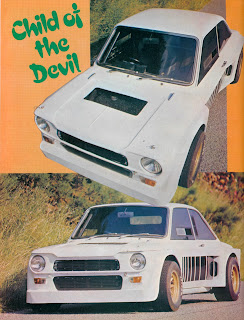| Schmoking! Must be something pretty competitive to get this far up Simms on the Exeter... |
| That can't be right! An X90 almost cleaning Simms? Nick and Liz Deacon from Stroud show that it is - almost - possible. Maybe next year? |
So we were a non starter and I went to watch at Simms instead.
| These guys breezed up on their heavy metal trials irons |
Simms was hard. I think I saw no more than 20 cars get up. I arrived just in time to see the last of the bikes go up and Simon Eliot on his ISDT Triumph and Steve O'Connor on his BMW R80GS made it look easy.
Only when the four wheelers began did it become apparent how difficult Simms was.
 |
| Mike Pearson and Graham Proctor also made it look easy in their 1600 Dellow |
I saw the very smart VW Notchback of Dean and Arthur Vowden get up. I see in the programme that this is listed as having 2056cc so that no doubt helped. This is the car that suffered the indignity of a suspension collapse on Warleggan in last year's Land's End. This occurred just beyond the recovery tractor, which then had to get down the hill, filter through all the waiting queues of competitors and go the long way round to recover the car from the top.
| Adrian Booth's old car is now highly developed and James Shallcross showed Simms that he's The Daddy |
Also James Shallcross in the ex-Adrian Booth Peugeot 205 - I think this was the only Class 1 car to clean Simms. Dave Haizelden in his Golf hit a bump that threw him off course and spoilt his progress, blowing a tyre in the process.
Lester Keat flew up in his Class 3 Avenger. I was telling some of my fellow spectators to look out for him and Dick Bolt in his Escort but Dick turned out to be standing a little way up the hill from me. He'd had electrical problems on the car but should be out again for the Land's End. Other notable spectators among my section of hedge were Tris White, of VW powered Imp fame (VT No. 49) and Dennis Greenslade and Shree Tonkin.
My how we groaned when Roger and Julia Bricknell didn't even get up to the "A" boards. If no cars in a Class clear the hill but someone reaches these they are deemed to be the class winner. However, in Class 7 - which is the class for Team Robert's Candidi Provocatores Allard and the Bricknell's trials-spec Vincent - I saw no cleans this year on Simms although I heard a rumour that a Liege managed it before I pitched up.
And then we groaned again at every Suzuki X90 that turned the corner for they just don't seem to work, despite so much being in their favour. That was until the Deacons did their stuff...
The crowd went nuts. It was a very knowledgeable gathering that clearly knew what marked good driving. It was such a shame they somehow couldn't get any further having got that far. A nonchalant shove from the marshals and away they went, happy to have shown us what an X90 can do. It certainly altered my opinion of them.
As the day wore on the section became more polished and hardly anything got up. Mike Warnes broke his prop but had a spare and after some manhandling to get off the section he had a spare joint and got going again.
John Aley used to call this sort of thing "mechanical heroism" and that's as good an example as I can think of.
The crowd went nuts again for Melanie Hobbs in her Beetle but although she got further than many other Beetles no matter how much we hollered Simms claimed another victim after a valiant struggle.
It was getting dark by the time the closing car came through and I set off for the Trecarn Hotel for the Club supper. Team Robert had booked in along with our entry and I thought I might just as well join in as I had tickets. Getting to the hotel was easy. I just had to follow the muddy cars and after a quick brush up I had a long chat with Dave Symons from Liskeard. He once gave me a 928cc Imp engine when I was campaigning my Llama (VT No.22) and he was using a Sunbeam rwd hatchback.
Over the supper I fell in with a group of XT600 riders from Class O. There were 79 entrants in Class O and although some people see Class O as diluting the main trial and using up too many marshals, at least these guys were "the right side of the fence" as Peter and Johnathan Thompson would put it. Class O has got many people involved who would not otherwise enter and I will admit to being put off by how rough the sections are (unless you have a buddy with an Allard, of course). These XT riders had thoroughly enjoyed themselves.
| "All the best two stroke trial bikes are made by dictators." Eastern Bloc or fascist, you can take your choice. |
| I had to compliment these guys on their ascent of Simms. At speed Keith Newton can nearly stand his "Loose Cannon" on its tail |
Meanwhile, here's looking forward to the 2013 Land's End in the Allard with Binky in full working order.








































